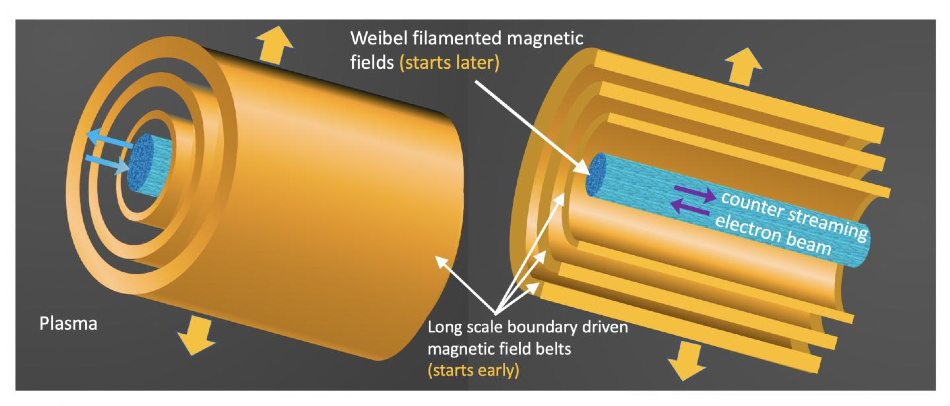Sep 15 2020
A group of physicists from India and Japan has challenged a 60-year old old notion that the massive magnetic field in a high-intensity laser created plasma that originates from the small, nanoscale in the bulk plasma.
 Magnetic field in beam-plasma interaction: The field begins at the beam boundary and is larger than that in the bulk. Image Credit: Ratan Bera.
Magnetic field in beam-plasma interaction: The field begins at the beam boundary and is larger than that in the bulk. Image Credit: Ratan Bera.
But the team revealed that the magnetic field actually evolves at macroscopic scales demarcated by the boundaries of the electron beam propagating in the plasma.
The novel mechanism strives to modify one’s interpretation of magnetic fields in astrophysical setups and laser fusion, and may help design advanced high-energy particle sources for therapies and imaging.
Massive magnetic fields, which are billion times that of the Earth, are present in the hot, dense plasma in astrophysical systems such as neutron stars. Elementary electromagnetism defined from the times of Oersted and Faraday informs that it is the current in a system that produces magnetic fields.
There are two currents in a plasma—one is a forward propagating one and the other is an opposite, mitigating current triggered by the forward one itself.
There is no net magnetic field if the currents are identical and overlapped in space. But slight fluctuations in the plasma can isolate them and result in instability that develops with time.
For many years, the massive fields were actually believed to emerge from the interplay of opposing currents within the bulk plasma through the well-known Weibel instability, at scales relatively smaller than the beams themselves. The magnetic field is then assumed to spread out to macroscopic space through the so-called inverse cascade, in a “bottom up” style.
By contrast, the Indo-Japanese group demonstrated that the field evolves at the edge of the current beam that is at macroscopic length scales and travels inward to smaller scales (top down). The magnitude of this field is relatively greater than that caused by Weibel and other instabilities.
The researchers called the mechanism resulting in this magnetic field “finite beam mechanism” to specify the vital role of the finite size of the current beam in this mode. They demonstrated that radiation escapes the boundaries of the current destabilizing the beam and producing the magnetic field. There is distinct evidence for this mode in their computer simulations and laser experiments.
But why was this new mode overlooked in all the computer simulations over the past several years? The study’s authors pointed out that this is because of the assumptions of homogeneity and infinite extent characteristic of all simulations.
But real physical systems are known to have boundaries and the underlying physics results in many fascinating effects—examples include the focusing of charged particles by the fringe fields towards the end of capacitor plates, the well-known Casimir effect leading to attraction between the plates caused by quantum effects, and also the surface propagating electromagnetic modes, called surface plasmons, quite prevalent in near-field microscopy and nano-optics.
Journal Reference:
Das, A., et al. (2020) Boundary driven unconventional mechanism of macroscopic magnetic field generation in beam-plasma interaction. Physical Review Research. doi.org/10.1103/PhysRevResearch.2.033405